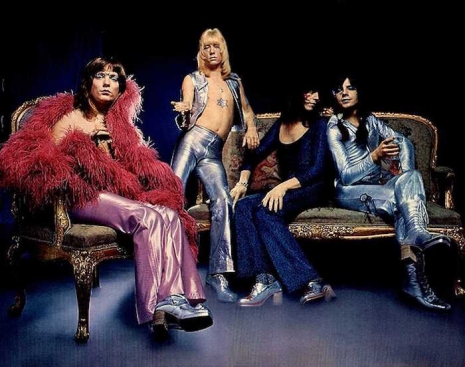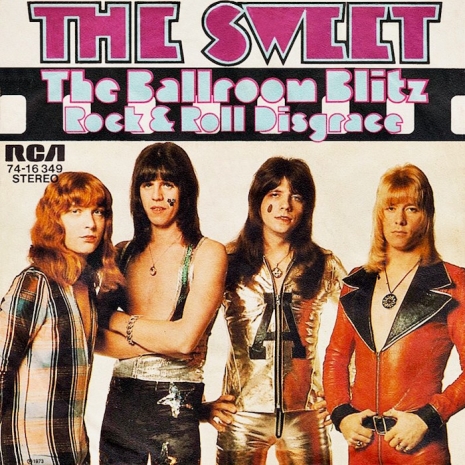
Well now, I suppose you could call it art out of chaos. That in a sequinned nutshell is the story behind Sweet‘s “The Ballrooom Blitz.” For glam rock’s catchiest trashiest most lovable song was inspired by a riot that saw the band bottled off the stage at the Grand Hall, Palace Theater, Kilmarnock, Scotland, in 1973. Boys spat and hurled abuse while girls screamed their loudest to drown out the music. Hardly the kind of welcome one would expect for a pop group best known for their million selling singles “Little Willy,” “Wig-Wam Bam” and of course their number one smash “Block Buster.”
Why this literal teenage rampage (the title of another Sweet hit) ever occurred and what caused such unwarranted and let’s be frank unnecessary violence against such four lovable glam rockers has been the focus of much speculation over the years.
One suggestion was the band’s androgynous nay effeminate appearance in figure-hugging clothes, eye-shadow, glitter, long hair and lipstick—in particular the gorgeous bass player Steve Priest—was all too much for the sexually binary lads and lassies o’ Killie.
Bass player Priest thinks so and has said as much in his autobiography Are You Ready Steve? But this does raise the question as to why an audience of teenage Sweet-haters would pay their hard-earned pocket money to go and see a bunch of overtly camp rockers they hated?
Money was tight. After all this was 1973 when the country was beset by cash shortages, food shortages, strike action, power cuts and three-day work weeks. People couldn’t afford to waste their readies on some pseudo queer bashing.
Moreover, homosexuality was out and proud, Rocky Horror was on the stage, Bowie was the androgynous Ziggy Stardust, teen magazines were giving boys make-up tips, and the #1 youth program was the BBC’s music show Top of the Pops—on which Sweet appeared to have a weekly residency.
Another possible reason for such fury was the virulent rumor Sweet didn’t play their instruments and were just a “manufactured” band like The Monkees. This story gained credence as the famous song-writing duo of Nicky Chinn and Mike Chapman, who wrote and produced Sweet’s hit singles were well-known to prefer using session musicians to actual members of a given group. It was just easier and faster to leave it to the pros.
The sliver of truth in this well-known rumor was the fact Sweet only sang on their first three Chinn-Chapman singles “Funny, Funny”, “Co-Co” and “Poppa Joe”. It wasn’t until the fourth “Little Willy” that Chinn and Chapman realized Sweet were in fact waybetter musicians than any hired hand and so allowed the band to do what they did best—play their own instruments.

Give us a wink…
Chinn and Chapman may have blessed Sweet with their Midas hit-making skills but it came at a price. This unfortunately meant the band was dismissed by London’s snobbish music press as sugar-coated pop for the saccharine generation. A harsh and unfair assessment. But this may also have added to the audience’s ire.

Give us a wink…
Chinn and Chapman may have blessed Sweet with their Midas hit-making skills but it came at a price. This unfortunately meant the band was dismissed by London’s snobbish music press as sugar-coated pop for the saccharine generation. A harsh and unfair assessment. But this may also have added to the audience’s ire.
In an effort to redefine themselves with the public Sweet also tended to avoid playing their best known teenybopper hits when on tour. Instead they liked to perform their own compositions—the lesser known album tracks—and a set of standard rock covers. A band veering from the songbook of hits (no matter how great the material) was asking for trouble. As Freddie Mercury once said after Queen made their comeback at Live Aid, “always give the audience what they want.”
But it was the album tracks that gave Sweet and glam rock itself its distinct sound. The credit for this must go to Andy Scott’s guitar playing (his six-string prowess was often favorably compared to the talents of Jimmy Page and Jeff Beck), Steve Priest’s powerful bass and harmonizing vocals, and Mick Tucker’s inspirational drums (just listen to the way he references Sandy Nelson’s “Let There Be Drums” in “The Ballroom Blitz”). Add in Brian Connolly’s vocals and it is apparent Sweet were a band with talents greater than the sum of their bubble gum hits might indicate.

So what went wrong?

So what went wrong?
If ever there was a tale of a band making a pact with the Devil for some top ten hits then the rise and fall of Sweet is that story. A tale of talent, excess, fame, money, frustration and then the slow decline into alcohol, back-taxes, ill health, early death and disaster.
Half of the band is now tragically dead. In the mid-seventies, Connolly was badly beaten-up outside a pub in Staines—an attack that permanently damaged his singing voice. He later survived fourteen heart attacks brought on by his alcoholism and drug use. He ended his days playing holiday camps with his version of Sweet.
The hugely underrated drummer Tucker sadly succumbed to cancer in 2002.
The two remaining members Priest and Scott allegedly don’t speak to each other. They perform on two different continents with their own versions of The Sweet. Priestwho lives in California tours America. While Scott who still lives in England tours Europe—he is currently on his “Last Encore Tour.”
This is the real world of pop success.
Yet I doubt they would ever change a thing. And I doubt the fans would ever let them.
But back to that night in a theater in Kilmarnock when the man at the back said everyone attack and the room turned into a ballroom blitz. Whatever the cause of the chaos it gave glam rock a work of art—and Sweet one of their finest ever songs.
Bonus: ‘All That Glitters’—24-hours in the day of the life Sweet filmed in 1973.
cool. great entry. Totally enjoyed it. My first favorite band! 7th grade Bochum Germany eating pomme frites on the corner... yeah.
ReplyDeleteWho sez there's no going back?